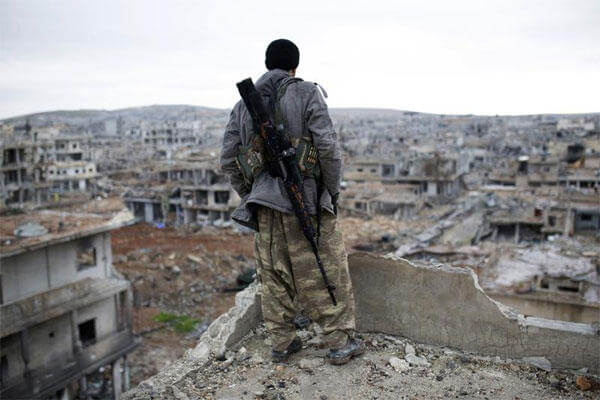The U.S.-led coalition expressed concern Thursday over clashes in Syria between separate U.S.-backed factions with competing agendas that could complicate the drive to take a key ISIS stronghold.
British Maj. Gen. Doug Chalmers said the reported fighting between the mostly Syrian-Arab Free Syrian Army elements and the Kurdish YPG (People's Protection Units) militia had not yet risen to the level of a "significant rift," but "there is tension, yes."
In a briefing to the Pentagon from Baghdad, Chalmers, the deputy commander for strategy and sustainment of Combined Joint Task Force-Operation Inherent Resolve, said the tension between the groups "reflects the complexity of Syria," where an estimated 300,000 have been killed in five years of a civil war that has displaced millions, brought Russia into the conflict and spawned myriad militias with various political aims.
The FSA was fighting to topple the regime of Syrian President Bashar al-Assad while the YPG was focused on securing Kurdish areas in northeastern Syria.
Chalmers said he was relying on secondary reports but suggested that the infighting between the YPG and the FSA was "no more now than it has been probably for the last couple of months."
His assessment was in contrast to what representatives of the two factions told Reuters on Wednesday.
"There is a deepening divide between us," the politburo chief of the Jabha Shamiya, one of the major FSA rebel groups in the Aleppo area, told Reuters. "If there is no quick political solution between the revolutionaries and the Kurds, it is heading toward escalation."
YPG spokesman Redur Xelil said that his group wanted to avoid conflict with FSA but added that "If they want a war, they will certainly lose."
On other issues, Chalmers said that the Iraqi Security Forces (ISF) had cleared about 70 percent of the city of Fallujah, which the Baghdad government claimed to have liberated last week.
The ISF has established a solid presence in the northern sector of Fallujah and is working to oust remaining ISIS fighters from the rest of the city about 40 miles west of Baghdad, Chalmers said.
Chalmers cautioned against reports from the Syrian Observatory for Human Rights monitoring group that the U.S-backed Syrian Democratic Forces (SDF), supported by the YPG, had entered the northeastern Syrian city of Manbij in the effort to retake the ISIS stronghold and close off a main re-supply and access route for foreign fighters.
The SDF has taken some hamlets on the outskirts of Manbij, but the coalition believes that the SDF has not yet established a presence within the city, Chalmers said. "It's a matter of definition," Chalmers said of the estimates of progress against ISIS in Manbij.
Chalmers also said there was evidence that Russian warplanes used cluster bombs last week in strikes in southern Syria near Jordan's al-Tanf border crossing, far from where Russian planes have struck before in support of the Assad regime.
The Russian Defense Ministry has denied that the strikes took place, but U.S. officials said they were carried out by two Russian Su-24 attack aircraft.
Chalmers said a number of fighters from a U.S.-backed militia were killed or wounded in the airstrikes; he did not say how many. "We were very surprised at the strike near al-Tanf," Chalmers said. "Our people on the ground reported that they had been attacked by cluster munitions."
-- Richard Sisk can be reached at Richard.Sisk@Military.com.





























